Are you planning a trip to Vietnam and curious about the historical treasures it holds? What Artifacts Or Architectural Features Are Notable At The Tran Temple Complex? Discover the fascinating cultural heritage of the Tran Temple Complex with SIXT.VN. We offer seamless travel solutions, ensuring you experience the best of Vietnam. Delve into the intricate designs and spiritual significance of this iconic site.
1. What Is the Historical Significance of the Tran Temple Complex?
The Tran Temple Complex, also known as Đền Trần, holds immense historical significance as it commemorates the Tran Dynasty (1225-1400), a pivotal period in Vietnamese history. The Tran Dynasty is celebrated for its victories against the Mongol invaders, preserving Vietnam’s independence and cultural identity. The complex serves as a tribute to the dynasty’s emperors, generals, and significant figures, embodying the spirit of patriotism and resilience. According to historical records, the complex was constructed on the former site of the dynasty’s ancestral home in the 14th century, reinforcing its role as a place of origin and remembrance.
1.1. Key Historical Events Associated with the Tran Dynasty
- Three Victories Against the Mongols: The Tran Dynasty successfully repelled three major Mongol invasions in the 13th century, showcasing remarkable military strategy and national unity. These victories are a source of immense pride and are commemorated annually at the Tran Temple Festival.
- Cultural and Economic Development: The dynasty fostered a period of significant cultural and economic growth, marked by advancements in literature, arts, and agriculture. The Dai Viet Su Ky Toan Thu (Complete History of Dai Viet) is a notable historical record compiled during this period, providing valuable insights into Vietnamese history.
- Establishment of the Tran Court: The Tran Dynasty established a well-organized court and administrative system, which laid the foundation for future dynasties. This period saw the codification of laws and the promotion of Confucian principles, which influenced Vietnamese society for centuries.
1.2. How the Complex Reflects the Dynasty’s Achievements
The architecture and artifacts within the Tran Temple Complex symbolize the dynasty’s achievements and contributions to Vietnamese society. The imposing structures and intricate carvings reflect the power and prestige of the Tran emperors, while the ancestral tablets and memorial halls honor the dynasty’s key figures. The annual Tran Temple Festival, one of the most significant cultural events in Vietnam, serves as a living testament to the dynasty’s enduring legacy. The festival features traditional rituals, performances, and games that celebrate the dynasty’s victories and promote national pride.
1.3. SIXT.VN Enhances Your Historical Exploration
With SIXT.VN, you can delve deeper into the historical significance of the Tran Temple Complex. Our services include:
- Expert-guided tours: Providing in-depth insights into the history and cultural context of the complex.
- Convenient transportation: Ensuring a comfortable and hassle-free journey to and from the site.
- Accommodation assistance: Helping you find the perfect place to stay, allowing you to immerse yourself fully in the experience.
2. What Is the Architectural Layout of the Tran Temple Complex?
The Tran Temple Complex is meticulously designed, following traditional Vietnamese architectural principles and reflecting the cultural values of the Tran Dynasty. The layout is organized into three main temples: Thượng Temple (Upper Temple), Trung Temple (Middle Temple), and Hạ Temple (Lower Temple), each serving distinct ceremonial and historical purposes. This structured arrangement symbolizes the hierarchical order and spiritual significance inherent in Vietnamese temple design.
2.1. Detailed Description of Each Temple (Thượng, Trung, Hạ)
- Thượng Temple (Upper Temple): Dedicated to the worship of the Tran Dynasty’s ancestors, the Thượng Temple is the most sacred part of the complex. It features elaborate altars, ancestral tablets, and intricately carved wooden structures. The temple’s architecture reflects the reverence and respect accorded to the dynasty’s founders.
- Trung Temple (Middle Temple): This temple is used for important ceremonies and rituals, including the annual Tran Temple Festival. It houses statues of the Tran emperors and key figures, along with ceremonial objects and artifacts. The Trung Temple serves as a central gathering place for devotees and visitors.
- Hạ Temple (Lower Temple): The Hạ Temple is believed to be the site where the Tran Dynasty originated. It is a more modest structure compared to the other temples but holds significant historical value. The Hạ Temple serves as a reminder of the dynasty’s humble beginnings and its rise to power.
2.2. How the Architecture Reflects Vietnamese Temple Design
The Tran Temple Complex showcases classic elements of Vietnamese temple architecture, including:
- Symmetrical Layout: The temples are arranged in a symmetrical pattern, reflecting the Confucian principles of harmony and balance.
- Use of Traditional Materials: The structures are primarily constructed from wood and brick, with tiled roofs and ornate carvings. These materials are traditional to Vietnamese architecture and contribute to the complex’s aesthetic appeal.
- Courtyards and Gardens: The complex includes spacious courtyards and meticulously maintained gardens, providing a tranquil and contemplative atmosphere. These spaces are designed to promote spiritual reflection and connection with nature.
2.3. SIXT.VN Facilitates Your Architectural Exploration
SIXT.VN provides the resources to fully appreciate the Tran Temple Complex’s architectural brilliance. Our services include:
- Detailed maps and guides: Helping you navigate the complex and understand its layout.
- Transportation options: Ensuring a seamless and enjoyable visit to the site.
- Cultural insights: Offering background information on Vietnamese temple architecture, enhancing your appreciation of the complex’s design.
3. What Are the Notable Artifacts Housed Within the Complex?
The Tran Temple Complex is home to a variety of significant artifacts that offer insights into the history, culture, and religious practices of the Tran Dynasty. These artifacts include ancestral tablets, statues of emperors and mandarins, ceremonial objects, and historical documents, each with its own unique story and cultural value. Exploring these artifacts provides a tangible connection to Vietnam’s rich past.
3.1. Detailed Description of Key Artifacts (Ancestral Tablets, Statues, etc.)
- Ancestral Tablets: These tablets bear the names of the Tran Dynasty’s emperors and key figures, serving as focal points for ancestral worship. The tablets are adorned with intricate carvings and inscriptions, reflecting the dynasty’s reverence for its ancestors.
- Statues of Emperors and Mandarins: The complex houses statues of the Tran emperors and prominent mandarins, depicting them in regal attire and poses. These statues are revered as symbols of the dynasty’s power and authority.
- Ceremonial Objects: A variety of ceremonial objects, such as incense burners, offering bowls, and ritual implements, are used in religious ceremonies and festivals. These objects are often crafted from precious materials and adorned with symbolic motifs.
- Historical Documents: The complex preserves historical documents and inscriptions that provide valuable information about the Tran Dynasty. These documents include royal decrees, historical records, and religious texts, offering insights into the dynasty’s governance, culture, and beliefs.
3.2. Their Significance and Cultural Value
The artifacts within the Tran Temple Complex hold profound significance and cultural value, embodying the dynasty’s legacy and contributing to Vietnamese national identity. They serve as tangible links to the past, allowing visitors to connect with the history and culture of the Tran Dynasty. According to the Ministry of Culture, Sports and Tourism, these artifacts are considered national treasures, underscoring their importance to Vietnam’s cultural heritage.
3.3. SIXT.VN Connects You to Cultural Treasures
With SIXT.VN, you can experience these cultural treasures firsthand. Our services include:
- Exclusive access: Arranging for private viewings of key artifacts and historical sites.
- Expert guides: Providing detailed explanations of the artifacts’ history and cultural significance.
- Cultural immersion tours: Combining visits to the Tran Temple Complex with other cultural experiences, such as traditional music performances and culinary tours.
4. What Are the Decorative Elements and Artistic Motifs Featured in the Complex?
The Tran Temple Complex is adorned with intricate decorative elements and artistic motifs that reflect the cultural and religious values of the Tran Dynasty. These elements include carvings, sculptures, paintings, and calligraphic works, each contributing to the complex’s aesthetic beauty and symbolic meaning. Exploring these artistic details provides a deeper understanding of Vietnamese art and culture.
4.1. Description of Carvings, Sculptures, and Paintings
- Carvings: Intricate carvings adorn the wooden structures, depicting dragons, phoenixes, floral patterns, and scenes from Vietnamese folklore. These carvings showcase the skill and artistry of Vietnamese craftsmen.
- Sculptures: Sculptures of dragons, lions, turtles, and other mythical creatures guard the entrances and courtyards, symbolizing protection and good fortune. These sculptures are crafted from stone, wood, and bronze, reflecting the diversity of Vietnamese artistic traditions.
- Paintings: Paintings on the walls and ceilings depict historical events, religious scenes, and natural landscapes. These paintings are executed in vibrant colors and intricate detail, adding to the complex’s visual appeal.
4.2. Symbolism and Meaning Behind These Motifs
Each decorative element and artistic motif carries its own symbolism and meaning, reflecting the cultural and religious values of the Tran Dynasty.
- Dragons: Symbolize power, strength, and good fortune, often associated with the emperor and the ruling class.
- Phoenixes: Represent rebirth, renewal, and grace, often associated with the empress and female virtues.
- Floral Patterns: Depict beauty, harmony, and prosperity, often used to adorn altars and ceremonial objects.
4.3. SIXT.VN Illuminates Artistic Heritage
SIXT.VN helps you uncover the artistic heritage of the Tran Temple Complex with:
- Art and history tours: Focusing on the decorative elements and artistic motifs within the complex.
- Expert insights: Providing detailed explanations of the symbolism and meaning behind these motifs.
- Interactive exhibits: Showcasing the history and evolution of Vietnamese art and culture, enhancing your appreciation of the complex’s artistic details.
5. How Does the Tran Temple Festival Enhance the Complex’s Significance?
The Tran Temple Festival is an annual event that significantly enhances the cultural and historical significance of the Tran Temple Complex. Held in the first lunar month, the festival commemorates the victories of the Tran Dynasty against the Mongol invaders and honors the dynasty’s ancestors. The festival features a variety of traditional rituals, performances, and games, attracting thousands of visitors from across Vietnam and abroad.
5.1. Description of the Festival and Its Activities
The Tran Temple Festival includes:
- Processions: Elaborate processions featuring traditional music, dance, and costumes, reenacting historical events and paying tribute to the Tran Dynasty.
- Rituals: Ceremonial rituals performed by monks and local dignitaries, including ancestral worship, offerings, and prayers for peace and prosperity.
- Games and Performances: Traditional games such as wrestling, chess, and martial arts, along with musical performances and theatrical productions, providing entertainment for visitors.
5.2. Cultural and Spiritual Importance of the Festival
The Tran Temple Festival holds immense cultural and spiritual importance, serving as a symbol of national pride and unity. The festival reinforces the values of patriotism, resilience, and respect for ancestors, promoting a sense of community and cultural identity. According to the Vietnam National Administration of Tourism, the festival contributes significantly to the preservation and promotion of Vietnamese cultural heritage.
5.3. SIXT.VN Ensures a Memorable Festival Experience
With SIXT.VN, you can experience the Tran Temple Festival to the fullest. Our services include:
- Festival tour packages: Providing transportation, accommodation, and guided tours of the festival.
- VIP access: Offering exclusive access to ceremonial rituals and performances.
- Cultural immersion activities: Allowing you to participate in traditional games, learn local crafts, and sample Vietnamese cuisine.
6. What Role Does the Complex Play in Modern Vietnamese Society?
The Tran Temple Complex continues to play a vital role in modern Vietnamese society, serving as a symbol of national identity, cultural heritage, and spiritual inspiration. The complex attracts visitors from across Vietnam and abroad, contributing to tourism and promoting cultural exchange. It also serves as a place for religious worship, historical education, and cultural preservation.
6.1. Its Importance as a Cultural and Tourist Site
The Tran Temple Complex is recognized as a national historical site, attracting tourists and scholars interested in Vietnamese history and culture. The complex provides valuable insights into the Tran Dynasty and its contributions to Vietnamese society. It also serves as a venue for cultural events and educational programs, promoting awareness and appreciation of Vietnamese heritage.
6.2. How It Is Preserved and Maintained
The Tran Temple Complex is preserved and maintained through the combined efforts of the government, local communities, and religious organizations. Restoration projects are carried out to repair and preserve the structures and artifacts within the complex. Cultural heritage programs are implemented to promote awareness and appreciation of the complex’s historical and cultural significance.
6.3. SIXT.VN Supports Sustainable Tourism
SIXT.VN is committed to supporting sustainable tourism at the Tran Temple Complex. Our services include:
- Eco-friendly transportation: Providing options for environmentally friendly transportation, such as electric vehicles and bicycle rentals.
- Responsible tourism practices: Promoting responsible tourism practices that minimize environmental impact and respect local culture.
- Community engagement: Partnering with local communities to support economic development and cultural preservation.
7. What Nearby Attractions Complement a Visit to the Tran Temple Complex?
Enhance your visit to the Tran Temple Complex by exploring nearby attractions that offer a deeper understanding of the region’s history and culture. The city of Nam Dinh, where the complex is located, and its surroundings boast numerous historical sites, scenic landscapes, and cultural landmarks that complement the experience. Combining your visit to the Tran Temple Complex with these nearby attractions ensures a comprehensive and enriching travel experience.
7.1. Suggestions for Other Historical and Cultural Sites
- Co Le Pagoda: A beautiful pagoda known for its unique architecture and serene atmosphere, located a short drive from the Tran Temple Complex. It offers insight into the region’s Buddhist heritage.
- Keo Pagoda: One of the oldest and most beautiful pagodas in Vietnam, featuring intricate wooden architecture and historical artifacts. It’s a significant religious and cultural site.
- Nam Dinh Citadel: Explore the remnants of the ancient citadel, offering a glimpse into the region’s military and administrative history. The citadel provides historical context to the Tran Dynasty’s reign.
7.2. Recommendations for Natural and Scenic Spots
- Thinh Long Beach: Relax on the sandy shores of Thinh Long Beach, a popular coastal destination offering beautiful scenery and recreational activities. It’s a perfect spot to unwind after exploring historical sites.
- Xuan Thuy National Park: Discover the diverse ecosystem of Xuan Thuy National Park, a UNESCO Biosphere Reserve, with its mangrove forests, migratory birds, and unique flora and fauna. It offers a natural contrast to the cultural sites.
7.3. SIXT.VN Tailors Your Itinerary
SIXT.VN assists you in crafting the perfect itinerary, incorporating both the Tran Temple Complex and nearby attractions. Our services include:
- Customized tour packages: Tailoring itineraries to your interests, ensuring you experience the best of the region.
- Transportation logistics: Providing seamless transportation between different sites, maximizing your travel time.
- Local insights: Sharing insider tips and recommendations for dining, shopping, and cultural experiences.
8. What Are the Essential Travel Tips for Visiting the Tran Temple Complex?
To ensure a smooth and respectful visit to the Tran Temple Complex, it’s essential to be aware of local customs, traditions, and practical considerations. These tips cover everything from appropriate attire and etiquette to transportation and accommodation, helping you make the most of your visit while honoring the site’s cultural and religious significance.
8.1. Guidance on Appropriate Attire and Etiquette
- Dress Modestly: Wear clothing that covers your shoulders and knees out of respect for the religious site. Avoid wearing revealing or overly casual attire.
- Remove Shoes: Take off your shoes before entering the temples. This is a common practice in Vietnamese temples and pagodas.
- Be Respectful: Maintain a quiet and respectful demeanor inside the temples. Avoid loud conversations or disruptive behavior.
- Photography: Ask for permission before taking photos, especially of monks or religious ceremonies. Be mindful of not disturbing the peace and tranquility of the site.
8.2. Practical Information on Transportation and Accommodation
- Transportation: Consider hiring a private car or taxi for convenient transportation to the Tran Temple Complex and nearby attractions. SIXT.VN can arrange reliable transportation services for you.
- Accommodation: Book your accommodation in advance, especially if you’re visiting during the Tran Temple Festival. Nam Dinh offers a range of hotels and guesthouses to suit different budgets.
- Local Currency: Have Vietnamese Dong (VND) on hand for small purchases and entrance fees (if any). Credit cards may not be widely accepted in smaller establishments.
8.3. SIXT.VN Offers Peace of Mind
SIXT.VN ensures a stress-free and enriching visit to the Tran Temple Complex. Our services include:
- Travel insurance: Providing comprehensive travel insurance for peace of mind during your trip.
- 24/7 customer support: Offering round-the-clock assistance with any questions or concerns you may have.
- Detailed travel guides: Equipping you with essential information and tips for visiting the Tran Temple Complex and other destinations in Vietnam.
9. How Has the Tran Temple Complex Influenced Vietnamese Art and Culture?
The Tran Temple Complex has profoundly influenced Vietnamese art and culture, serving as a source of inspiration for artists, scholars, and cultural enthusiasts. Its architectural style, decorative motifs, and historical significance have shaped various aspects of Vietnamese artistic expression, from traditional crafts to contemporary art forms. The complex embodies the values, beliefs, and historical narratives that are central to Vietnamese cultural identity.
9.1. Examples of Its Influence on Art, Literature, and Music
- Architecture: The architectural style of the Tran Temple Complex, characterized by its symmetrical layout, intricate carvings, and traditional materials, has influenced the design of other temples, pagodas, and historical sites in Vietnam.
- Literature: The historical events and figures associated with the Tran Dynasty have been featured in numerous literary works, including poems, plays, and historical novels. These works celebrate the dynasty’s achievements and promote national pride.
- Music: Traditional music and dance performances during the Tran Temple Festival reflect the cultural values and historical narratives of the Tran Dynasty. These performances have inspired contemporary artists to create new works that blend traditional and modern elements.
9.2. Its Role in Preserving Vietnamese Traditions
The Tran Temple Complex plays a crucial role in preserving Vietnamese traditions by serving as a repository of cultural artifacts, historical documents, and religious practices. The complex hosts cultural events and educational programs that promote awareness and appreciation of Vietnamese heritage. It also supports traditional crafts and artistic skills, ensuring that they are passed down to future generations.
9.3. SIXT.VN Advocates Cultural Preservation
SIXT.VN actively supports cultural preservation efforts related to the Tran Temple Complex. Our initiatives include:
- Cultural heritage tours: Providing educational tours that highlight the historical and cultural significance of the complex.
- Community partnerships: Collaborating with local communities to support cultural preservation projects and promote sustainable tourism.
- Philanthropic contributions: Donating a portion of our profits to cultural organizations that are dedicated to preserving Vietnamese heritage.
10. What Are Some Common Misconceptions About the Tran Temple Complex?
Despite its historical and cultural significance, several misconceptions surround the Tran Temple Complex. Addressing these misconceptions is crucial for fostering a deeper understanding and appreciation of the site. Clarifying these misunderstandings ensures that visitors approach the complex with accurate knowledge and respect for its cultural value.
10.1. Debunking Myths and Misunderstandings
- Myth: The Tran Temple Complex is only significant during the annual festival.
- Reality: While the Tran Temple Festival is a major event, the complex holds year-round significance as a historical site, religious center, and cultural landmark.
- Myth: The complex is solely dedicated to the worship of emperors.
- Reality: While the emperors are honored, the complex also pays tribute to key figures and ancestors of the Tran Dynasty, reflecting a broader scope of historical and cultural reverence.
- Myth: The architectural style is purely Vietnamese.
- Reality: The architecture blends Vietnamese and other influences, showcasing a fusion of cultural elements that contribute to its unique design.
10.2. Clarifying Its True Significance
The Tran Temple Complex is a multifaceted site that embodies the values, beliefs, and historical narratives of the Tran Dynasty. It serves as a symbol of national pride, cultural heritage, and spiritual inspiration. Understanding its true significance requires appreciating its historical context, architectural features, and cultural traditions.
10.3. SIXT.VN Provides Accurate Information
SIXT.VN is committed to providing accurate and reliable information about the Tran Temple Complex. Our resources include:
- Verified content: Ensuring that our articles, guides, and tour descriptions are based on credible sources and expert knowledge.
- Educational resources: Offering a variety of educational resources, such as historical timelines, cultural glossaries, and virtual tours.
- Responsive customer service: Addressing any questions or concerns you may have with prompt and helpful assistance.
SIXT.VN: Your Gateway to Exploring Vietnam’s Cultural Gems
Ready to explore the Tran Temple Complex and other cultural gems in Vietnam? SIXT.VN offers a range of services to make your trip seamless and unforgettable:
- Tailored Itineraries: Discover personalized travel plans designed to match your unique interests and schedule.
- Effortless Airport Transfers: Begin and end your journey with hassle-free transportation to and from the airport.
- Curated Hotel Selection: Choose from a handpicked collection of accommodations that suit your preferences and budget.
- Exclusive Tour Packages: Dive into Vietnam’s rich history and culture with our expertly guided tours.
- Convenient Flight Bookings: Find the best flight options to Vietnam with ease, ensuring a smooth start to your adventure.
Don’t let the challenges of planning a trip hold you back. Let SIXT.VN handle all the details, from transportation to accommodation, so you can focus on experiencing the best of Vietnam. Contact us today to start planning your dream trip!
Address: 260 Cau Giay, Hanoi, Vietnam
Hotline/WhatsApp: +84 986 244 358
Website: SIXT.VN
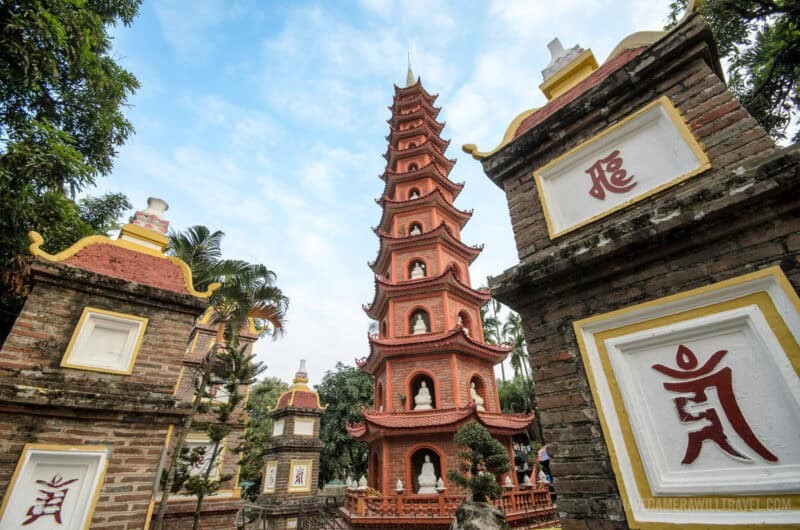 Tran Quoc Pagoda Hanoi TowerThe Tran Quoc Pagoda entrance gate and tower stand prominently on West Lake’s Golden Fish islet, showcasing traditional Vietnamese Buddhist architectural elements.
Tran Quoc Pagoda Hanoi TowerThe Tran Quoc Pagoda entrance gate and tower stand prominently on West Lake’s Golden Fish islet, showcasing traditional Vietnamese Buddhist architectural elements.
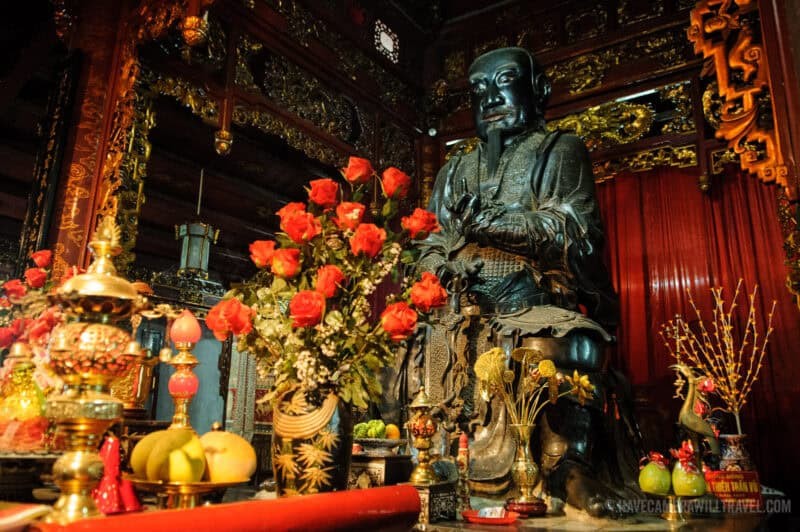 Tran Quoc Pagoda Hanoi ChapelAn ornate Buddhist shrine is featured within a side chapel inside Tran Quoc Pagoda, demonstrating traditional Vietnamese Buddhist artistic style and religious symbolism.
Tran Quoc Pagoda Hanoi ChapelAn ornate Buddhist shrine is featured within a side chapel inside Tran Quoc Pagoda, demonstrating traditional Vietnamese Buddhist artistic style and religious symbolism.
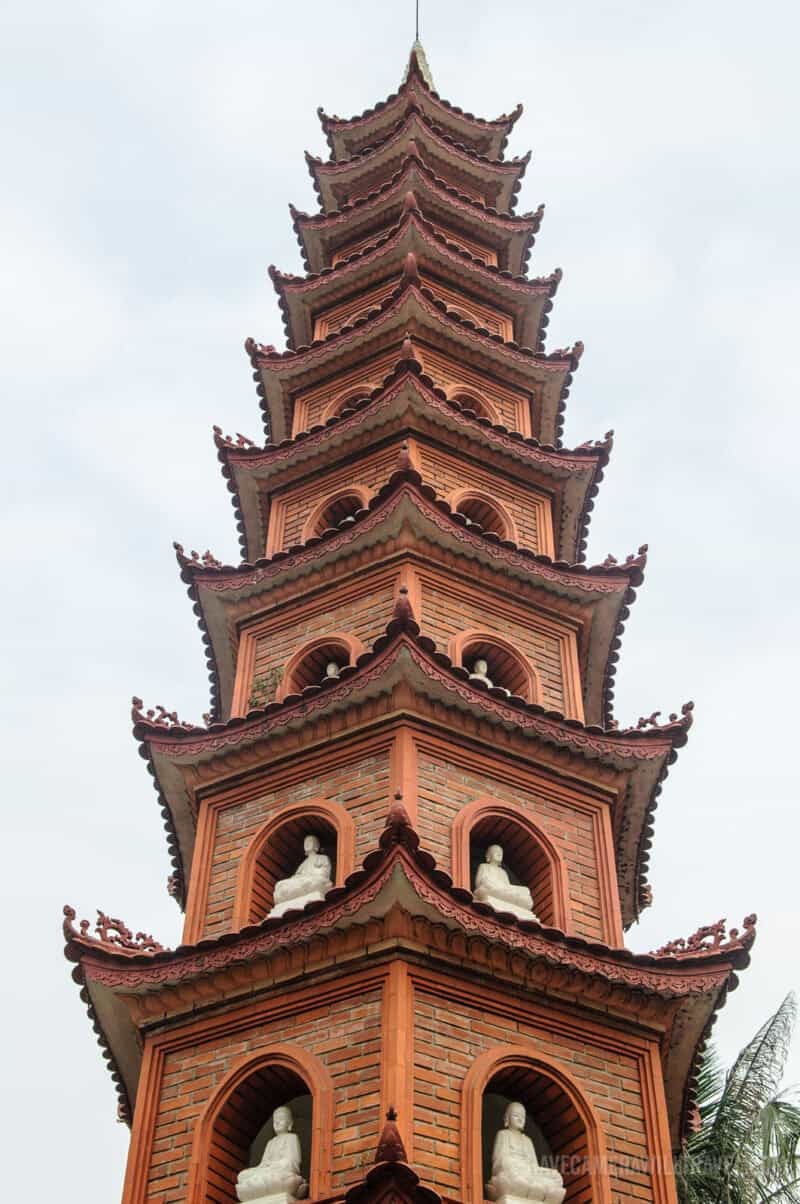 Tran Quoc Pagoda Hanoi Statue TowerThe brick tower of Tran Quoc Pagoda rises above West Lake, incorporating elements of traditional Vietnamese Buddhist architectural design.
Tran Quoc Pagoda Hanoi Statue TowerThe brick tower of Tran Quoc Pagoda rises above West Lake, incorporating elements of traditional Vietnamese Buddhist architectural design.
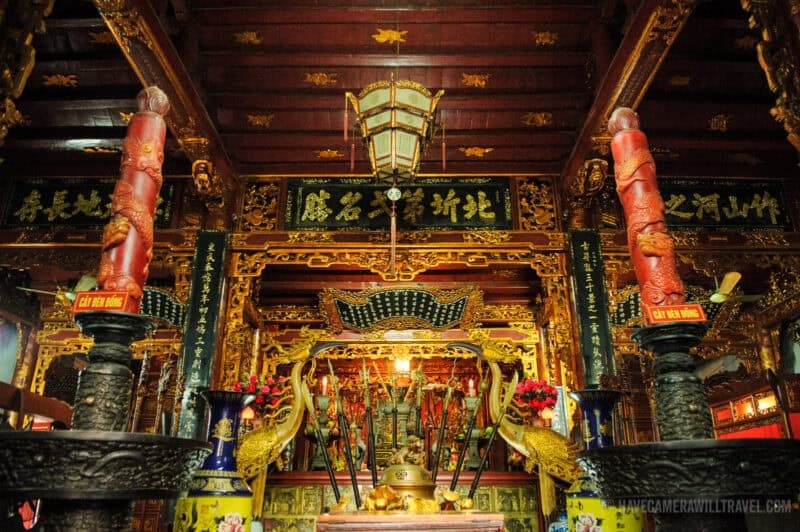 Tran Quoc Pagoda Hanoi AltarA devotional altar displays traditional Vietnamese Buddhist design elements within a chapel at Tran Quoc Pagoda.
Tran Quoc Pagoda Hanoi AltarA devotional altar displays traditional Vietnamese Buddhist design elements within a chapel at Tran Quoc Pagoda.
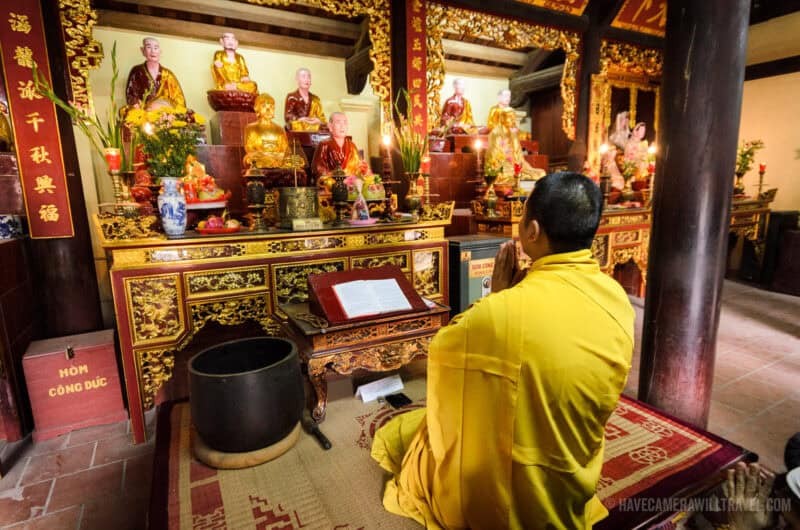 Tran Quoc Pagoda Hanoi Monk PrayingA Buddhist monk offers prayers at the altar inside Tran Quoc Pagoda, an active worship site located on West Lake.
Tran Quoc Pagoda Hanoi Monk PrayingA Buddhist monk offers prayers at the altar inside Tran Quoc Pagoda, an active worship site located on West Lake.
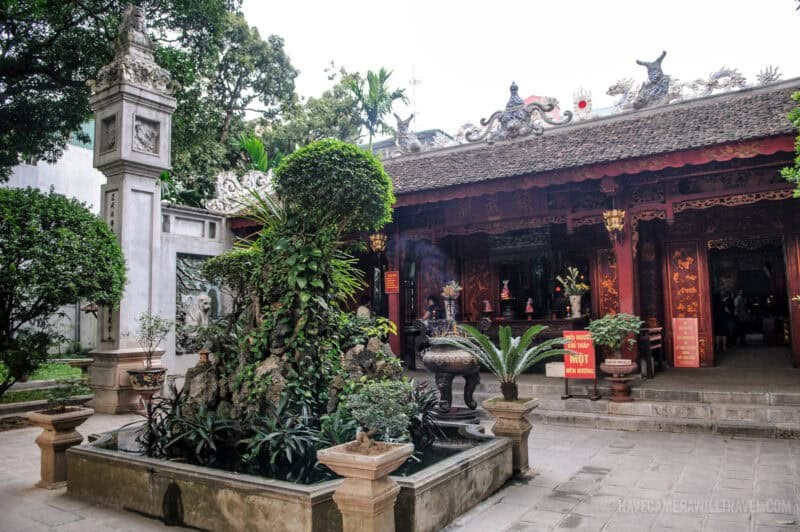 Tran Quoc Pagoda Hanoi CourtyardThe courtyard at Tran Quoc Pagoda, located on West Lake, offers an open gathering space reflecting traditional Vietnamese Buddhist architectural elements.
Tran Quoc Pagoda Hanoi CourtyardThe courtyard at Tran Quoc Pagoda, located on West Lake, offers an open gathering space reflecting traditional Vietnamese Buddhist architectural elements.
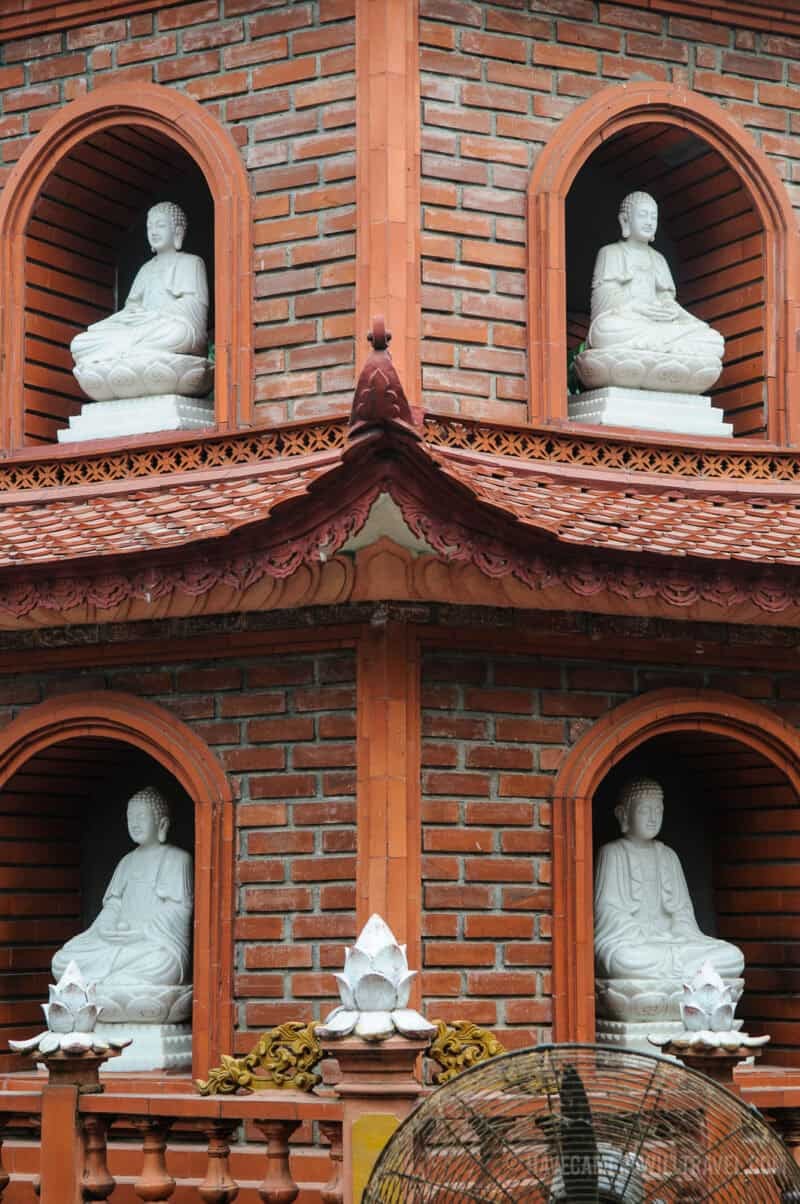 Tran Quoc Pagoda Hanoi StatuesWhite Buddha statues in alcoves decorate the brick tower of Tran Quoc Pagoda, exemplifying Vietnamese temple architectural sophistication.
Tran Quoc Pagoda Hanoi StatuesWhite Buddha statues in alcoves decorate the brick tower of Tran Quoc Pagoda, exemplifying Vietnamese temple architectural sophistication.
 Tran Quoc Pagoda Hanoi Buddhist Monk PrayingInside Tran Quoc Pagoda, a Buddhist monk prays at the altar, continuing a centuries-old tradition on West Lake.
Tran Quoc Pagoda Hanoi Buddhist Monk PrayingInside Tran Quoc Pagoda, a Buddhist monk prays at the altar, continuing a centuries-old tradition on West Lake.
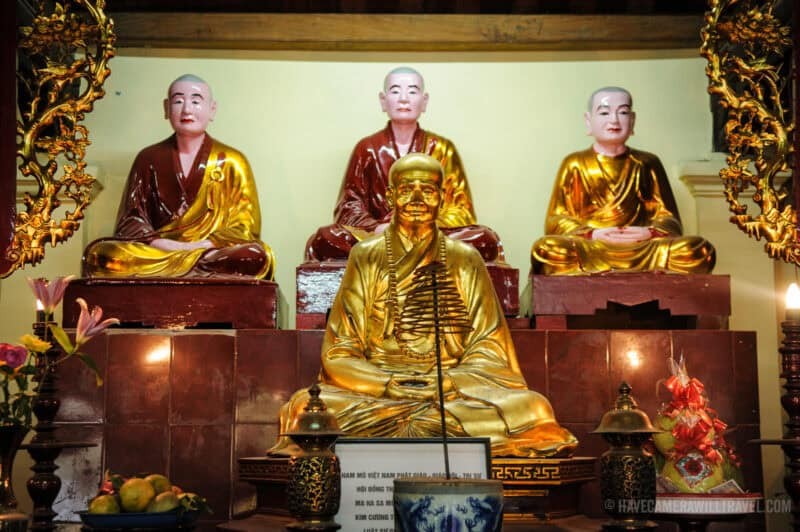 Tran Quoc Pagoda Hanoi Altar StatuesBuddhist statues adorn the main altar at Tran Quoc Pagoda, showcasing traditional Vietnamese Buddhist sculptural elements.
Tran Quoc Pagoda Hanoi Altar StatuesBuddhist statues adorn the main altar at Tran Quoc Pagoda, showcasing traditional Vietnamese Buddhist sculptural elements.
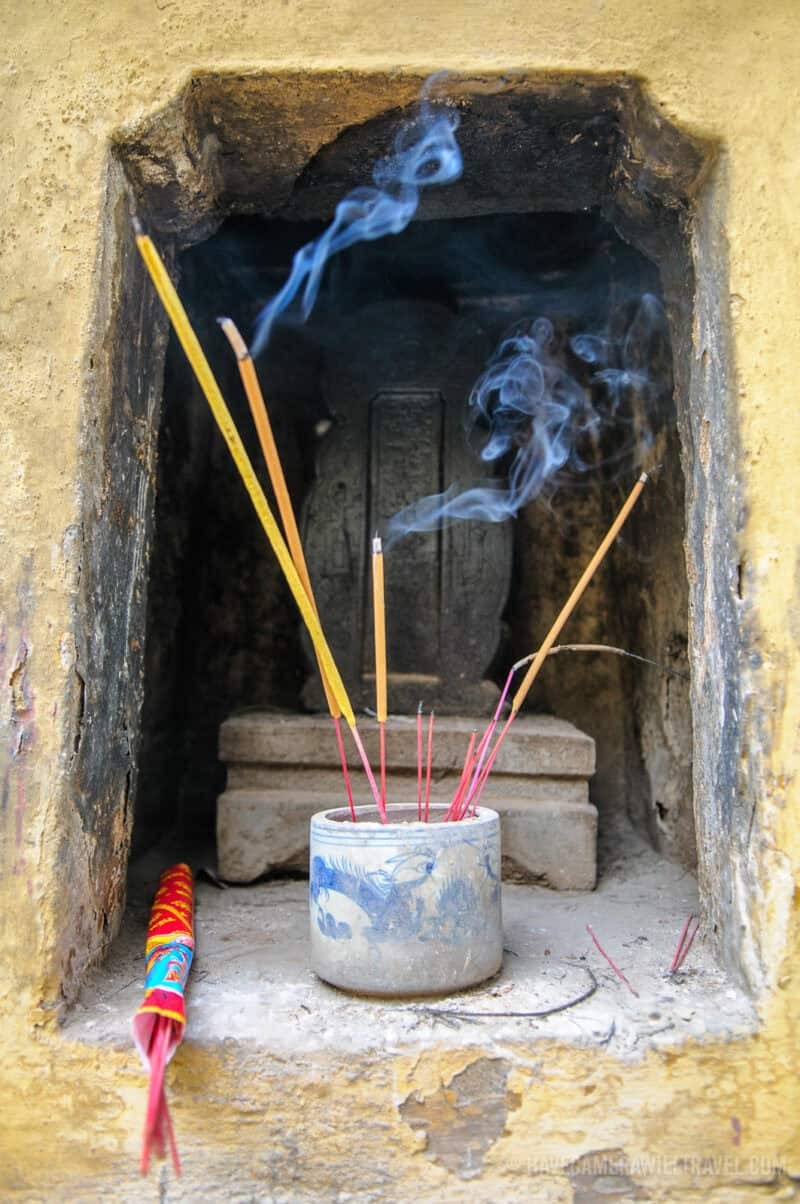 Tran Quoc Pagoda Hanoi IncenseBurning incense stands in a shrine at Tran Quoc Pagoda, maintaining traditional Buddhist offering practices on West Lake.
Tran Quoc Pagoda Hanoi IncenseBurning incense stands in a shrine at Tran Quoc Pagoda, maintaining traditional Buddhist offering practices on West Lake.
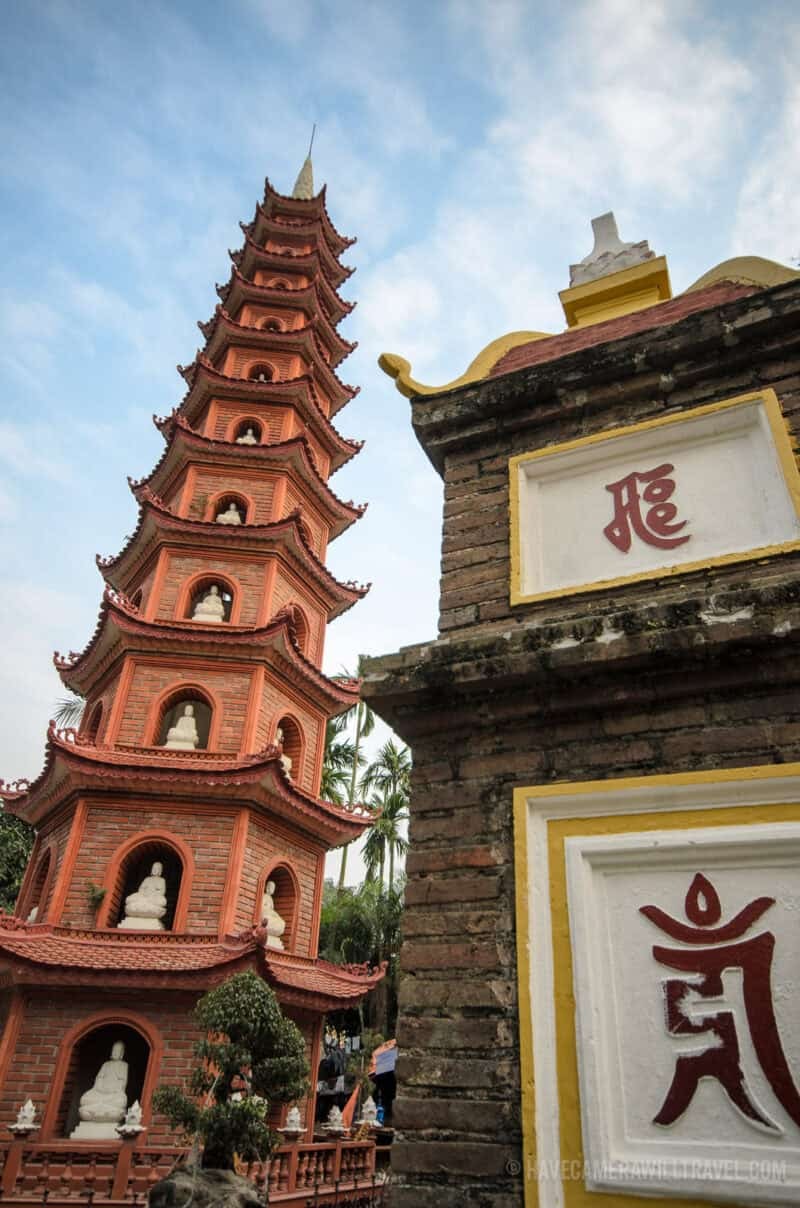 Tran Quoc Pagoda Hanoi Tower and GateThe entrance gate and tower of Tran Quoc Pagoda stand prominently on West Lake, reflecting traditional Vietnamese Buddhist architectural heritage.
Tran Quoc Pagoda Hanoi Tower and GateThe entrance gate and tower of Tran Quoc Pagoda stand prominently on West Lake, reflecting traditional Vietnamese Buddhist architectural heritage.



